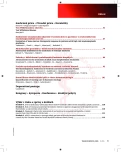Evaluation of bone marrow therapeutic response in patients with high risk myelodysplastic syndrome
Authors:
P. Vašeková 1; L. Plank 1,2; P. Szépe 1,2; J. Marcinek 1,2; T. Balhárek 1,2
Authors‘ workplace:
Konzultačné centrum bioptickej diagnostiky ochorení krvotvorby, Ústav patologickej anatómie JLF Univerzity Komenského a UN v Martine
1; Konzultačné centrum bioptickej diagnostiky ochorení krvotvorby Martinské bioptické centrum, s. r. o., v Martine
2
Published in:
Transfuze Hematol. dnes,21, 2015, No. 2, p. 67-73.
Category:
Comprehensive Reports, Original Papers, Case Reports
Overview
Myelodysplastic syndrome (MDS) represents a heterogeneous group of clonal disorders of haematopoietic bone marrow (BM) stem cells manifesting as ineffective haematopoiesis and morphologically visible dysplasias, leading to peripheral cytopenias involving one or more blood cell lineages. The clinical course of the disease is variable and individual. It may lead either to the onset of fatal cytopenias due to progressive BM failure or, on the contrary, to the development of secondary acute myeloid leukaemia (AML). Diagnosis of the disease requires close correlation of the clinical picture, laboratory parameters and standardized evaluation of BM biopsy. Despite some progress in the treatment of patients with higher risk MDS (IPSS group int-2 and high), the current therapeutic options are limited and usually allogeneic haematopoietic stem cell transplantation, chemotherapy, supportive care and hypomethylating therapy may be considered.
From 2008–2014, 76 patients were identified with high-risk MDS in our biopsy register who were treated with chemotherapy, the hypomethylating agent azacytidine or stem cell transplantation and whose bone marrow bio-psies were available before and after treatment. The effect of the applied therapy was evaluated with focusing on the histopathological type of MDS before and after therapy and also on any change of the histo-morphological picture, particularly the BM blast count, progression to secondary AML and progression of myelofibrosis. The series consisted of 76 patients (47 men and 29 women); the average age was 62 years (27–82 years). The most common type of high-risk MDS was RAEB 2 (32 patients) and secondary AML (21 patients). 39 patients were treated only with the hypomethylating agent azacytidine; in 12 cases chemotherapy was also administered. 22 patients were treated with chemotherapy alone. In 3 patients, only information about peripheral stem cell transplantation was available, the total number of transplantations was 7. Hypomethylating therapy resulted in: a) blast cell count reduction in 16% of cases, b) disease stabilization without striking changes of the morphological picture in nearly 42% of cases, c) rapid disease progression despite therapy in approx. 35% of cases and d) gradual progression of myelofibrosis during the disease course in 8% of cases. Whether the progression of fibrosis represents an effect of hypomethylating treatment or is part of the natural course of MDS remains unknown, the same is true for the persistence or progression of cytopenia/s.
Key words:
high risk MDS, hypomethylation therapy, bone marrow trephine biopsy
Sources
1. Cillioni D, Messa E, Mesa F, et al. Genetic abnormalities as targets for molecular therapies in myelodysplastic syndromes. Ann NY Acad Sci 2006; 1089:411–423.
2. Silverman LR. Hypomethylating agents in myelodysplastic syndrome changing the inevitable: the value of azacitidine as maintenance therapy, effects on transfusion and combination with other agents. Leuk Res 2009; 33 (2 Suppl):18–21.
3. Tefferi A. Myelodysplastic syndromes – many new drugs, little therapeutic progress. Mayo Clin Proc 2010; 85(11):1042–1045.
4. Garcia-Manero G. Treatement of Higher-Risk Myelodysplastic Syndrome. Sem Oncol 2011; 38(5):673–681.
5. Fenaux P. Treatment of high risk myelodysplastic syndromes (MDS) in 2013. European School of Hematology clinical updates in hematology on acute myeloid leukemia and myelodysplastic syndromes. Budapest, May 31 – June 1, 2013, Abstract Book, nečíslované abstrakty.
6. Anargyrou K, Vassilakopoulos TP, Angelopoulou MK, Terpos E. Incorporating novel agents in the treatment of myelodysplastic syndromes. Leuk Res 2010; 34(1): 6–17.
7. Sekeres MA. Are we nearer to curing patients with MDS? Best Pract Res Clin Haematol 2010; 23(4): 481–487.
8. Garcia-Manero G. CME information: Myelodysplastic syndromes: 2014 update on diagnosis, risk-stratification and management. Am J Hematol 2014; 89(1): 97–108.
9. Yamazaki J, Issa J-PJ. Epigenetic aspects of MDS and its molecular targeted therapy. Int J Hematol 2013; 97(2): 175–182.
10. Kröger N. Stem cell transplantation in MDS. European School of Hematology clinical updates in hematology on acute myeloid leukemia and myelodysplastic syndromes, Budapest, May 31-June 1, 2013, Abstract Book, nečíslované abstrakty.
11. Kadia TM, Jabbour E, Kantarijan H. Failure of hypomethylating agent-based therapy in myelodysplastic syndromes. Semin Oncol 2011; 38(5): 682–692.
12. Al-Ameri A, Cherry M, Garcia-Manero G, Quintás-Cardama A. Standard therapy for patients with myelodysplastic syndromes. Clin Lymph Myeloma Leuk 2011; 11(4): 303–313.
13. Gattermann N. How to treat MDS without stem cell transplantation. Biol Blood Marrow Transplant 2010; 16 (Suppl): 30–36.
14. Garcia-Manero G. Myelodysplastic syndromes: 2012 update on diagnosis, risk-stratification, and management. Am J Hematol 2012; 87(7): 692–701.
15. Steensma DP. Can hypomethylating agents provide a platform for curative therapy in myelodysplastic syndromes? Best Pract Res Clin Haematol 2012; 25(4): 443–451.
16. Zeidan AM, Linhares Y, Gore SD. Current therapy of myelodysplastic syndromes. Blood Rev 2013; 27(5): 243–259.
17. Brunning RD, Orazi A, Germing U, et al. Myelodysplastic syndromes. In: Swerdlow SH, Campo E, Harris NL, et al. World Health Organization classification of tumours of hematopoetic and lymphoid tissues. Lyon: IARC Press, 2008; 87–107.
Labels
Haematology Internal medicine Clinical oncologyArticle was published in
Transfusion and Haematology Today

2015 Issue 2
Most read in this issue
- Von Willebrand disease
- Monoclonal antibodies in the treatment of multiple myeloma
- Evaluation of bone marrow therapeutic response in patients with high risk myelodysplastic syndrome
- Advancements in the treatment of adult acute lymphoblastic leukaemia
